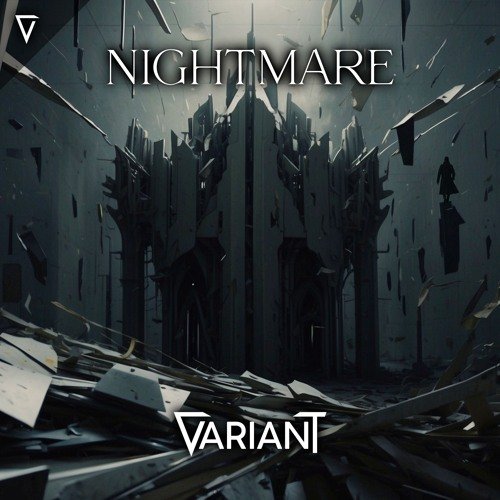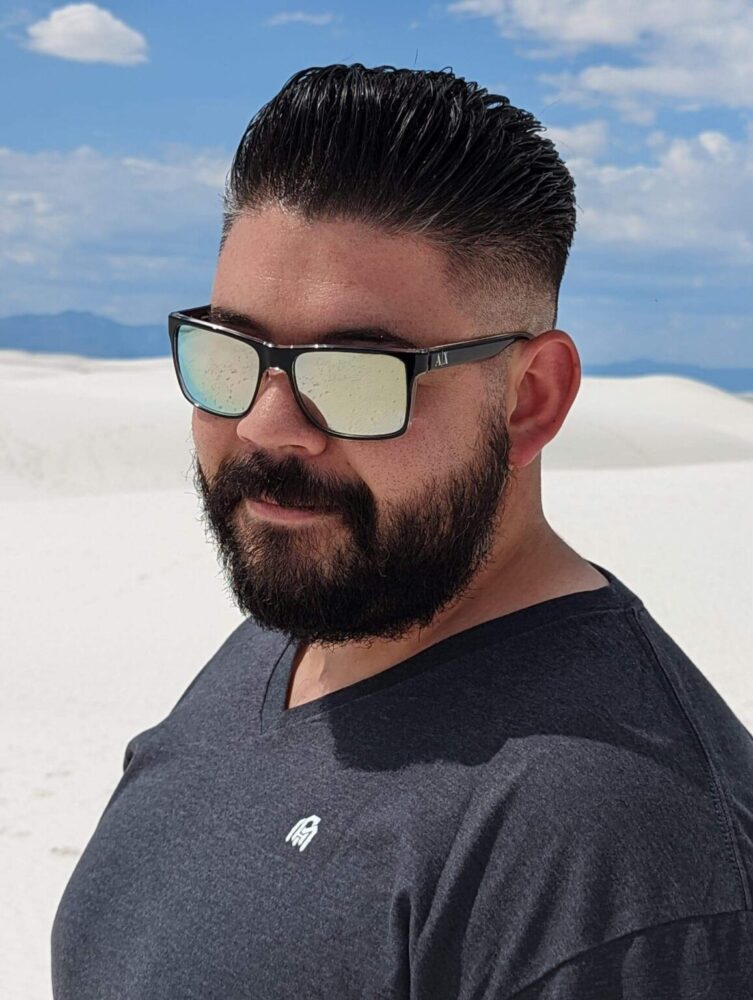
From the heart of groundbreaking scientific research at Los Alamos National Laboratory emerges VARIANT, a producer whose sonic blueprint merges his deep tech expertise with cinematic soundscapes. After making waves with his debut single ‘GENESIS’ – a track that seamlessly weaves future bass elements reminiscent of DROELOE and Marshmello with soaring orchestral arrangements.
VARIANT now returns with ‘NIGHTMARE’, an immersive mid-tempo journey that follows a haunting narrative of dreams turned dark.
Working as a Cybersecurity Technician at one of the world’s most prestigious scientific institutions by day, VARIANT brings a uniquely analytical approach to music production. At Los Alamos, where cutting-edge research spans from bio-plastics to quantum computing, he’s witnessed firsthand how technology pushes boundaries – a mindset that bleeds into his meticulous sound design and arrangement techniques.
‘NIGHTMARE’ exemplifies this technical precision, featuring intricate vocal chops that morph into distorted guitar riffs, orchestral swells that build tension, and masterfully crafted transitions that simulate sonic erosion. The track tells the story of a young girl’s recurring nightmare, with each element carefully engineered to pull listeners through its dark narrative arc.
Drawing inspiration from film composers like Hans Zimmer while channeling the electronic innovation of Skrillex, Zedd and REZZ, VARIANT’s production style sits at an intriguing crossroads between theatrical scoring and contemporary dance music.
It is time to get an update from Joel following our initial interview in January.
We discover insight about sound design and plugins used to produce ‘NIGHTMARE’, current developments at the Los Alamos National Laboratory, VARIANT’s top 5 favorite tracks at the moment and more.

The 2 minute marker of ‘NIGHTMARE’ starts to take us on a quest, what is a little of your vision of the journey you are taking us on?
For this track at the beginning, I had a vision to musically illustrate what it would be like when a dream turns into a nightmare. This musical journey starts where a young girl went to sleep and her dream contorted into a nightmarish world. Now in the world, horrid entities were trying to capture her and take her to their master. By the end of the first drop the young girl was able to get away from them and wake up from her nightmare.
Around the 2 minute mark of this song time fast forwards to where this young girl grew up and is getting ready to go to bed like any normal night until an old, but familiar feeling starts to erode her dream.
This time the master entity makes his appearance with the huge brahms and as the song builds up to the second drop then leads to “the chase”. The end, I wanted to resolve it as the woman once and for all being able to trap the evil entity and her nightmare finally becomes a wonderful dream again.
I love the intro vocals, where did you find those and how are they classified? Any vocalist you can shout out?
I am so glad you like the intro vocals. The intro vocals would be considered “vocal chops”. I found some acapellas of songs and chopped up pieces I liked and was able to stitch them to what you hear today.![]()
Can you share a little about the sound design for ‘NIGHTMARE’? Any sounds or techniques you experimented with in the studio the first time?
Sure! For the synthetic sounds, I wanted to have a grungier/more rock sounding elements. I used plugins like Serum by Xfer Records to get the base sound I wanted, then used distortion plugins like Guitar Rig by Native Instruments, Thermal by Output, OTT by Xfer Records, and Ableton’s stock Saturator plugin to sculpt the tone and distortion I was looking for and then use vsts like Soothe2 by Oeksound and Pro Q3 by Fabfilter for subtractive EQing to cut out isolated and range frequencies and to tame harsh frequencies that were poking through at the end.
For transitional sections of the song, I wanted the listener to feel like whimsical moments were eroding away and to get that effect, I used Ableton’s stock bitcrusher plugin, Endless Smile by Dada Life, and Ableton’s stock Auto-Filter plugin to automate when the sounds would get washed out by Endless Smile, when bit crushing would build up and when the low pass filter setting would drag down across the EQ spectrum. Altogether it sounds like fading erosion.
Lastly for the Organic Sounds/elements like the vocals, strings, cellos, orchestral drums/impacts and for the music box chimes I wanted them to sound as natural but detailed as possible. The main thing I did was use light compression with Ableton’s stock compressor and OTT by Xfer Records to pull all the details from these elements and lastly used Soothe2 by Oeksound and Pro Q3 by Fabfilter for subtractive EQing to cut out isolated and range frequencies and to tame harsh frequencies overall.
As far as sounds, the music box and the epic brahms were definitely new sounds that I have never used before. The addition of these elements really brought this track to a different level. For new techniques, I have been really focusing on more technical aspects when it comes to production. Some techniques I have tried in NIGHTMARE are “Gain Staging” which is mainly the process of adjusting the volume levels of audio signals at different stages of production to ensure optimal sound quality. The more plugins that are being added to a chain, the more the original audio signal will be influenced because every plugin acts differently. The other technique I used in this track is Mid/Side EQing and monitoring. Main reason for this is to combat phasing issues that could arise. Phasing is mainly the timing relationship between multiple sound waves which indicates how these waves align or misalign when interacting. Depending on how these waves align, it could boost or cancel out elements in your song even though it wasn’t intended. Using tools like SPAN and MSED by Voxengo helped to be able to see these phasing relations, and also dial mid/side signals to not have phasing problems.
For layering in my projects. I tend to have a lot of tracks, so I group them in ways to make it easier for me to organize like elements and to treat like elements differently when it comes to EQing and other processing. I mainly always have group names titled: “Vox (For multiple Vocals)”, FX (effects)”, “Bass”, “808s (when added)”, “Kick” “Snare”, “Drop Synths” “Drop Accents”, “Strings”, “Cellos”, “Orchestral Drums” and “E. Guitar”
What are five tracks and/or artists you have been listening to lately?
Any new interesting developments with bio-polymers, hydrogen fuel cell technology and “Crossroads”? Are there any newly interesting things that you can share about working at Los Alamos?
For the Hydrogen Fuel Cell tech, a new hydrogen fuel cell research, development and manufacturing facility opened in Massachusetts with the help of Los Alamos fuel cell technologies. With this new facility it will help drive fuel cell technology forward with the main goal to implement zero-emission fuel cell technology in trucking and heavy equipment vehicles.
For “Crossroads” it is fully functional and has been beneficial to experiments being done at LANL. Since this is such an immense unit in size as a whole. A mini version of the same architecture is being made for users to develop codes and work in an open environment without having to be at the main unit for testing. Also talks of the next gen supercomputer is on the horizon since crossroads will be “sunsetted” in 2027. What was learned from Crossroads will be used as a stepping-stone for the new upcoming supercomputer (name not given yet).
As far as new interesting things I have been seeing is that LANL has been leaning into A.I. research more.
One field has a new Machine learning model to identify drug design possibilities. A research team led by Los Alamos National Laboratory recently used machine learning, an application of artificial intelligence, to identify molecular properties that could guide the discovery of new types of antibiotics, especially among pathogens deemed critical by the World Health Organization due to their high bacterial resistance. Another is a new proof by Los Alamos National Laboratory scientists shows that a technique called “overparameterization” enables quantum machine learning algorithms to find the highest point in the landscape — the solution to a problem — without getting stuck on false peaks.
It’s a better way to rule out false positives.
All this info can be found at: https://www.lanl.gov/
Are there any other technological advancements you find interesting or which is the coolest to you?
This might be a little controversial, but AI tools that are related to music production and music production techniques like mixing and mastering. I find it interesting mainly because of how fast these technologies are advancing. With tools like SUNO AI, it is amazing and terrifying how easy it is to make a song just by a prompt. Additionally, for any music producer the topic of mix and mastering it can be a daunting task to achieve, but I have been seeing more plugin companies incorporating AI features to help aid in that process. It will be interesting to see how music will be made in the future.
For example, being able to make a modern song, but being mixed and mastered as if I am in Quincey Jones studio when he made Thriller or Pink Floyd’s “The Wall” album. It will definitely add a new layer of aesthetics in music production that hasn’t been tapped into yet.
What has inspired you from Hanz Zimmer’s works?
To be honest, Hanz Zimmer is able to not only enhance movie scenes with his works, but even when you listen to the same works with your eyes closed you can easily build whole new worlds entirely. This level of storytelling is what I strive for in my works. Additionally the versatility in styles, moods, and world building this man has in every song he creates is just inspiring.
Also listen to VARIANT’s – ‘GENESIS’
Follow VARIANT:
SoundCloud | Instagram | X | Audius
The post VARIANT Shares Sound Design for Mid-Tempo Journey ‘NIGHTMARE’ and Developments from Los Alamos appeared first on EDM | Electronic Music | EDM Music | EDM Festivals | EDM Events.





